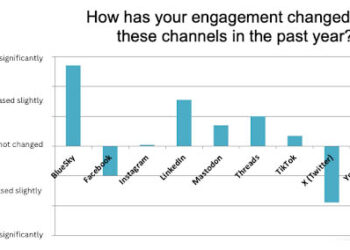
The ALPSP Awards — scholarly publishing’s nod to the brightest innovations and the best contributions in our sector — took place last month. (Congratulations to Alice Meadows, of ORCID and The Scholarly Kitchen, who received the Award for Contribution to Scholarly Publishing, and to Taylor & Francis and Wiley, whose Cartoon Abstracts and ChemPlanner, respectively, shared the Award for Innovation in Publishing).
Since the awards I’ve had a couple of curious conversations with people essentially positing that there is no innovation in scholarly publishing and that the sector is ripe for disruption. I must admit it’s a phrase I’ve probably uttered at times. But when the shoe is on the other foot (as a past winner of the ALPSP Award for Innovation, I care about what it represents), I ponder what “ripe for disruption” means. In the case of scholarly publishing, it seems to mean that while there is plenty of evolution (in publishing technologies, business models, processes, etc.) it should be happening faster. There is a gap between where we are now, and where we want to be, and plenty of people are eyeing that gap and thinking “for the love of Pete, there just needs to be foo.” I use foo as a catch-all term for the kinds of developments or disruptions people commonly call for in scholarly communications:
- a more open approach to (peer review / journal hosting / metrics / etc.)
- a more unified approach to (discovery / metadata exchange / identifiers / etc.)
- a more elegant approach to (manuscript submission / mobile interfaces / comment sharing / etc.)
- etc.
Being willing to sacrifice sacred cows is of course an important aspect of innovation, but for foomongers, it’s the only aspect of innovation that matters — it’s essentially their definition of disruption. (Others would define disruption with more nuance — this TechCrunch piece does a good job, explaining that it’s about competing with established players not by re-inventing what they do, but by finding the bits they’re not doing — markets that are unprofitable for them, or that for some other reason they aren’t serving — and building a business there.) Foomongers plan to disrupt scholarly publishing by developing a better way of doing something, to which everyone will quickly transition (because, as noted, it’s better). The trouble is, of course, that while a lot of foo ideas are good, and they are picking up on things that do need improving, the idea is the easy bit. However good your idea, however necessary, however perfectly in tune with the zeitgeist, nothing happens quickly. Not development, not adoption. Every success story is the top of a huge iceberg of time and effort, and probably money. For every Spotify or iPhone, there are a thousand quiet failures, buried by:
- Lack of added value – your idea, and its execution, need to be substantially, cosmically better than the entrenched norm for people to overcome switching barriers. And of course, this applies even when your innovation is providing something completely new, because there are just as many barriers to switching from “doing nothing, doing fine” to “doing something, potentially doing better, but who knows?” – particularly, one might argue, in scholarly communications where any innovation is already a footnote for busy (and often conservative) academics for whom publishing is already a peripheral activity. Ask the various “Facebooks for Science” that have started up over the years (see also “poor timing,” below).
- Wrong focus – one example might be journal hosting platforms. To the untrained eye, they may seem bloated, bristling with bells and whistles, and particularly unsuited to open access content, because in that case, all anyone wants is a PDF, right? And yet when you try to go to market with something pared back to the basics, you find yourself struggling to keep up with demand from publishers and librarians for the features they rely on. Yes, readers might just want a PDF. But publishers and libraries want OpenURL, and COUNTER stats (yes, even for open access content), and so on.
- Parasitism – this is so obvious I almost didn’t include it, but for a series of posts this week on the ERIL list about users complaining to libraries about blocked access to Sci-Hub. To be clear, if I’ve read the original post correctly, this is random people — not affiliated to the institution, but attempting to access Sci-Hub using credentials that have been phished from it — obliviously and politely demanding that the library reinstate access so they can meet their research needs. Jim O’Donnell on liblicense has an interesting take on the positive implications of this for libraries, but needless to say, from a disruptor perspective, dependence on someone else’s infrastructure or content is a risk, particularly if you are unable to mitigate that risk with partnerships and service level agreements.
- Optimism about the achievability of better – or less poetically, lack of money. Simplicity is deceptive. Elegant user experiences typically don’t grow from the ground up; they are usually the result of huge investment in refinement — focus, filter, forget — until complex tasks are distilled into beautiful processes. Show me a system or app that you admire and I’ll show you a building full of product managers, information architects, UX designers, quality assessors, and beta testers (as David Crotty said in giving this post an editorial review, “Apple’s true success is less about catching lightning in a bottle, and more about slow, incremental evolution“). Show me a bargain APC and I’ll show you complaints about the quality of the peer review, editing, or production values.
- Wrong team – many would-be disruptors fail to recognize strategic gaps and bring in the right people to fill those gaps. For example, academia is alive with start-ups whose strong ideas are rooted in well-understood market needs — but most don’t progress, because the founder is primarily focused on his or her academic career, and lacks the capacity or business expertise to ensure those strong ideas are well executed.
- Underinvestment in marketing – building on that same point, I meet a lot of people who have executed an idea well but, further down the line, are broke and bitter and bemused about why their brilliant, beautiful innovation still hasn’t taken off. Conspiracy theorists lurk here but mostly, painfully obviously, it’s because of a “build it and they will come” expectation, and an underestimation of the extraordinary efforts and costs that will have gone into promoting successful incumbents. According to various studies cited in this post, marketing investment in successful companies ranges from 10%-50% of revenue, with smaller companies investing more, and those trying to launch consumer products (essentially what many academic start-ups are trying to do) investing most.
- Poor timing – coincidentally, as I’m writing this, Robert Harrington has posted about “the art of balance.” He touches on the need for organizations to find the “right time” for innovation, and the same is true for new players seeking to bring about change. When’s the right time to launch? When your idea doesn’t just meet a need (not urgent enough) but solves a problem (or better still, addresses a requirement)? When disenchantment with the incumbents’ failure to do this is so strong you can taste it? When your product is ready? (deliberately not my first point here, as launch timing should be about more than just when you’ve finished development). As Robert says, getting the timing right may mean “not going first”. Facebook wasn’t first to market. Spotify wasn’t first to market. Apple wasn’t first to market. In the digital publishing sense, scholarly players were first to market, and this is why the tag “ripe for disruption” is so often bandied about. The established players — publishers themselves, journal hosts, manuscript submission systems — might be characterized as the Blackberry of our sector. They were quick to embrace digital and got web-based services to market quickly — meaning that their challenge ever since has been how to maintain and innovate at the same time (rebuilding the plane while flying it). Potential disruptors get to come in late, learn from progress made by the pioneers, and develop something leaner, sexier — and cheaper.
Dodging all of these pitfalls requires experience. It’s not necessary that that experience comes from the sector you seek to disrupt, but as Joe Esposito has also pointed out here in the Kitchen, it will surely help you if it does. Innovators on the inside are more powerful, because they know the size and shape of the switching barriers, and the weak spots within them. They know the market dynamics and who the customer is. They have realistic expectations of what it will cost to achieve their goals, and what kinds of people and activities will be necessary to make that happen. They might even once have been disruptors themselves, as one could suggest commercial publishers are in terms of having shifted the business model of the university-press dominated journals market in the middle of the last century (thanks to David Crotty for reminding me of this, and Mike Clarke’s thought-provoking post on the topic). When I look at many of the foomongers eyeing up scholarly publishing today, I see people trying to reinvent what they currently see, rather than looking at the market and trying to understand its problems afresh. They think the established players in scholarly publishing are Blackberries; I wonder if in fact they’re Apples — not currently at the peak of popularity, but with the potential to use their experience to innovate from within, thereby leapfrogging the Blackberry to come up with the iPhone.
Discussion
28 Thoughts on "Ripe for Disruption – From Within?"
Well before Amazon existed, the AAUP came up with the idea for an Online Catalogue and developed it into a working model for university presses. This innovation succeeded up to a point, but when Jeff Bezos decided to plow millions of dollars into developing Amazon.com. AAUP had to bow out because it could not compete either in scale or in level of investment. As Charlie suggests, it takes much more than good ideas to succeed in this business.
What about PDF? Is everyone happy with PDF because unless there is some out of the box thinking, PDF will use of another 5 yeas or more. Does that make you happy or sad?
Thanks for this great post, Charlie.
I was just looking at the web site for “Innovations in Scholarly Publishing” at https://101innovations.wordpress.com
which has for a while now been cataloging innovations in our niche. IIRC, it started as 100 innovations, then went to 400, and is now over 600.
There is, apparently, a lot of litter and a number of main attractions on the innovation highway — probably many victims of just the factors you describe.
The motivation for a lot of these innovations seem to be from the research community itself, where someone says, “this workflow is fubar, and I can fix it!”**. So a new tool is born.
I use this list of innovations as a type of digital dowsing rod to see where workflow is frustrating a lot of people.
**”fubar” is not related to “foo” as far as I know, but the same dictionary will explain both
http://www.urbandictionary.com/define.php?term=fubar
Since this is a polite website, I won’t say more.
Hi John – good thinking to link to Bianca and Jeroen’s list of scholarly innovations – it certainly tells the foo / fubar story well. And no doubt those with more capacity to dodge the pitfalls mine it for good ideas going nowhere, that they can either acquire or replicate. (I had to double check for my original post that foo was not related to fubar, since I once got castigated for using snafu in an email campaign and thought I’d better not make that mistake again!)
I would add one additional item in the list of developments or disruptions people commonly call for in scholarly communications, namely a realignment of the profit sharing model, so that content generators and their employers enjoy a fair share of the profits generated as a result of their content, resulting in an increase in additional research funding, enabling additional content dissemination.
Thanks, Daniel. You make me laugh because I was sure I had put “business model” or similar as an entry in that list but on scrolling back up I see I really didn’t. So thanks for flagging it – it’s certainly one of the things that many disruptors in our sector (yourselves included!) are strongly focussed on.
And yet the trend is moving just in the opposite direction. Rather than sharing profits with authors, we’re seeing a movement toward charging them directly for services rendered. Right now, page/color charges aside, the author gets those services for free and readers are charged with covering their costs. If we do away with the subscription model, then authors will pay for the services themselves, and the readers get things for free. Which puts a higher burden on research funding, given that subscription revenue (at least in the US) comes mostly from tuitions and student fees, while article processing charges will likely come out of research funding.
I disagree with your perception of the trend David. If this was the case, we would not have published in excess of a half million scholarly/education books on behalf of these academic authors, and would not have been motivated to develop a new user interface and brand to accommodate them. As regards the OA model you allude to, Book Processing Charges and Article Processing Charges will drop considerably in comparison with the traditional publishing subscription model, such that research funds will go much farther than at present. Libraries and research institutes will gladly circumnavigate traditional academic publishers in order to see their money go much farther!
Well, good luck with that. The actual evidence that I’ve seen makes it clear that OA will be vastly more expensive for those producing research results than subscription models, as it concentrates all expenses on the individual researcher, rather than spreading them broadly across the entire community. Further, it is a mistake to entirely assume that any savings experienced by a university will be put toward research. I suspect that while productive schools will need to divert money away from research to pay higher publishing costs, non-productive schools will channel their savings into things like athletic teams and administrator salaries.
Well ‘good luck with that’ is hardly a valid rebuttal. Academics are voting with their wallets. Reducing BPCs by 1/3 in comparison with traditional publishing will create great opportunities for funding, and I would prefer for these funds to support alternative university activities rather than to augment the ridiculous profit margins of traditional publishers.
Sent from my iPhone
I think “good luck with that” is a perfectly reasonable response to an unproven strategy that I see as wishful thinking. You may very well prove me wrong, but until I will wait until I see it to believe it. You and I likely agree about keeping publishing funds within the academy and supporting publishers with more reasonable profit margins, but my experience with universities suggest that it is very unlikely that any cost savings seen by libraries will be given over to fund research, rather than put toward activities more likely to drive university profits, such as building a new rock climbing wall to move up a few notches in the US News & World Report university rankings.
As regards article based publishing, the proof is in the pudding, but not as regards academic book publishing. Yes David, we are brothers in arms in our ambitions to redirect revenue streams away from the ‘big five’ and others. Personally I would prefer for these funds to support university budgets in any respect than for this to go to commercial publishers, but it is the content generators who will have an increasing level of influence as to where these funds go.
Just what is disruption? Seems a catchy word, especially by those who are on the outside looking in on an industry. It used to take at least 6 weeks to get a manuscript from author to publisher then all of a sudden it took seconds. It seems to me that disruption is a word used by those who have little or no experience in both work and life. Disruption happens in time and it just creeps along, and is accepted as the norm because we cannot remember when the disruption occurred.
I went to sleep last night as a 5 year old on the porch where it was cool and woke up this morning and I was 75 years old and living in a villa with air conditioning. Disruption is progress and it comes either very quickly, in leaps and bounds or just creeps up on you. For disruption to be successful it has to be planned and thought out. Oh, how I remember the talk of the internet moving in dog years and all those disruptive enterprises where millions were lost.
Hi Harvey, that’s a good point that a lot of major change happens incrementally – and that people on the outside looking in often don’t see its trail and assume it has happened quickly and disruptively. I think you and I agree that disruption needs to be planned and thought out if it is to be successful. Your last point has got me thinking about “disruptions that succeeded but have since failed”. A future post perhaps!
One of the sacred cows is the Ingelfinger rule. As far as I understand it, it was originally formulated to maximise the press coverage of an article by ensuring it didn’t appear anywhere else before the big splash in NEJM. It’s since mutated into a rule that forbids duplicate submission and duplicate/prior publication.
The increasing adoption of pre-prints has forced journals to re-examine what they count as prior publication. Wider recognition that publication in a journal is equivalent to a ‘brand’ for the paper might force a rethink on duplicate publication. Why can’t a paper that originally appeared in journal X be republished in journal Y, if the Editors of journal Y think it fits their scope as well?
I don’t think the Ingelfinger Rule morphed into something preventing duplicate publication. That’s a new conflation for me. I think duplicate publication is prohibited because it’s a bad thing to encourage, full stop.
What benefit would we get from having the same paper published in multiple journals?
For what it’s worth, Wikipedia conflates the Ingelfinger rule and duplicate publication: https://en.wikipedia.org/wiki/Ingelfinger_rule
As to why a paper appearing in multiple journals could be a good thing: imagine a paper on an important method developed in field X but highly relevant (and unknown) in field Y. A journal in Y feels that the paper would be of great interest to their readership, and they therefore republish it. That puts in front of their readers in a way that a citation or a blog post never can achieve.
There are, of course, an issue with attribution of citations and with copyright, but those are technical/legal problems and not reasons in themselves.
I should also draw a distinction between authors submitting the same paper to multiple journals to maximize their chances of success in the least possible time, which I think we should discourage, and a paper published in one journal subsequently appearing in another. The former can lead to the paper being accepted at 2 or more journals, and a) wastes the journals’ time and b) inflates the authors’ record. What’s the harm with the latter?
Interesting thought. Does a paper in this scenario actually need to be republished in the second journal – or just listed on the contents page of journal Y, with a referrer access link to the original paper in journal X? I quite like the interdisciplinary cross-fertilisation potential of an “of possible interest” section, with perhaps comments from the editors as to why papers have been included. It’s the curated, browsable version of semantic text mining and federated search perhaps.
I think perhaps it’s a semantic confusion — to me, Ingelfinger is more about “we are the first to publish this” rather than a measure taken to block duplicate publication in multiple journals. It’s more about making a big splash with an announcement, and something I think is increasingly archaic and on the way out.
Publishing the same paper in multiple journals would violate the rules around DOIs and create citation confusion. One would assume that the two journals would have at least slightly different formats and would each do their own rounds of peer review, resulting in different papers with different content. Which one do you cite? And if you’re a researcher and writing and publishing are distractions taking you away from your real work (research), how much time do you want to spend writing up the same paper multiple times, doing multiple rounds of revision for multiple journals, etc.?
All these are very valid points! I don’t know of any business plan that breaks either rule. I was just suggesting that these rules are decades old and part of community folklore. Breaking them causes consternation (cf above) but little damage, which makes them a good example of the sacrifice-ready sacred cow that Charlie talks about in her post.
Great post, Charlie. I’m not sure which of these is my pick for a pull quote:
However good your idea, however necessary, however perfectly in tune with the zeitgeist, nothing happens quickly.
or
Simplicity is deceptive.
Dear Charlie,
Many thanks for another thought-provoking post. At the same time, can I play Devil’s Advocate and express a mildly subversive series of thoughts from the other side of the schol comm fence, concentrating on books in the arts and social sciences, as this is where I think your closing remarks about ‘understanding the real problems of the market’ are particularly au point. I have worked (mainly) in this bit of the sector for over thirty years, and can safely say that innovation was emphatically more unpopular with the significant constituencies with which we dealt than the lack of same. As MD of Cambridge, I used to receive far more messages of complaint about sins of omission, services that the Press had once performed for its authors (like sending out galley proofs, or printed copies of published reviews of books), than for any perceived failure to innovate in striking ways. The vast majority of our authors, and indeed our customers and readers, seemed to want us to go on doing exactly what we had always done, making elegant and authoritative (and inevitably quite expensive) books designed to last one hundred years. Reconciling the schol comm imperatives of (say) a 60-year-old professor of classics at Freiburg and a 27-year-old postdoc at Stanford was not and is not easy, but there is a danger in current narratives that the latter cohort is seen as innately more interesting, more morally resonant, and somehow more representative of ‘the market’ than the former, and it is precisely because the focus of so many of the ‘disruptors’ is on people like themselves that they misunderstand the nature of the academic market, and of the power relations that prevail within it. For a reinforcement of this (small c) conservative position, I would refer SK colleagues to the fascinating recent Library Journal report on e-book take-up in US academic libraries,
As I say, this is a deliberately rhetorical post, but there is often a reason why cows become sacred…
Hi Richard – the process of innovation is certainly challenging – as you say, people rarely ask directly for it, and if you do consult your market you will mostly get a demand for “faster horses” (https://hbr.org/2011/08/henry-ford-never-said-the-fast) – hence the need to understand their challenges and apply your own thinking to how to resolve them rather than just reinventing or incrementally adapting how things are now. To your point about the 60-year-old vs the 27-year-old, I am sometimes a bit disheartened by how similar their viewpoints will be, in that early career scholars’ expectations, behaviours and needs are shaped around those of their supervisors, who are interested in retaining the status quo rather than seeking a new paradigm where (a) they will have to learn new ways of doing things and / or (b) they might not come out with the same status they currently have. In STM journals, early career researchers are still utterly focussed on the Impact Factor, and I’m sure there are similar norms dominating the arts / social science books world. Only a really compelling alternative, addressing core needs in a new and better way, launched at the right time and supported by either grassroots advocacy or lots of marketing, is going to unseat the incumbents – and that’s probably as it should be, in that we don’t want to throw babies out with the bathwater, so indeed we agree that an understanding of the current market dynamic is important to any potential disruption. (Thanks for the link to the LJ article – we had a very similar story at last year’s UKSG One-Day Conference, http://www.uksg.org/event/novconf2015, particularly from the student panel who opened a lot of eyes with their simple views on their print vs ebook choices).
Also perhaps worth mentioning — Silicon Valley-style “disruption” does not work universally, and may not be appropriate for some endeavors:
http://money.cnn.com/2016/10/05/technology/elizabeth-holmes-theranos-minilab/index.html



